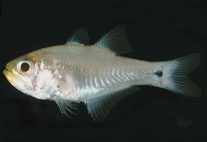Abstract
Archamia is restricted to a single species, A. bleekeri. A recently described genus, Kurtamia, a reference to a suggested relationship with the enigmatic Kurtus, is the junior synonym of Archamia. Kurtamia bykhovskyi is a junior synonym of A. bleekeri. Archamia is redescribed using osteological, color pattern, pore and free neuromast patterns supplementing those characters used in other publications noting clear differences between A. bleekeri and all other species formerly in that genus. The new genus Taeniamia, type species Archamia leai contains the remaining species. Osteology, color patterns and lateralis characters are reviewed for Taeniamia leai and other species. Species placed in Taeniamia have two broadly different color patterns: 1) yellow, orange, red or dark bars with or without a dark basicaudal spot, and 2) yellow or dark midline stripe with another stripe above the lateral line, lacking bars. These color patterns suggest two lineages exist within Taeniamia. New species combinations are: Taeniamia ateania, T. biguttata, T. bilineata, T. buruensis, T. dispilus, T. flavofasciata, T. fucata, T. kagoshimana, T. leai, T. lineolata, T. macroptera, T. melasma, T. mozambiquensis, T. pallida, and T. zosterophora. Archamia and Taeniamia are sister genera. A diagnosis is provided for the Apogonidae: one or two anal spines, first spine small, supernumerary in position, second spine or first anal fin-ray (only Paxton) in serial association with first distal and proximal-middle radials; first segmented anal ray branched; males mouth brood fertilized eggs; swim bladder simple without anterior or posterior modifications, a dorsal oval and ventral gas glands; free neuromasts on head, body and caudal fin. Characters of Holapogon were used to help identify common plesiomorphic characters for the Apogonidae, elsewhere among percoids using the Centropomidae and information for basal Percomorpha. A table of basal characters and derived changes is provided for the Apogonidae. Characters for two species Kurtus indicus and K. gulliveri are described and examined in a search for morphological synapomorphies with Archamia, Taeniamia, Holapogon and other apogonids. A diagnosis is provided for the Kurtidae: highly modified ribs, anterior dorsal spines individually fused with all radials of the pterygiophore complex, medially fused pterosphenoids, gill rakers on second branchial arch, tooth plates between each gill raker, serrated curved extension of the male’s supraoccipital crest, tiny cycloid scales on head and body, very short pored lateral-line scales and free neuromast patterns on the head and body. The second epibranchial articulating with third pharyngobranchial and radial ridges simple or bifid filaments around the micropyle of the egg related to egg ball organization are supported as possible non-exclusive synapomorphic characters for kurtids and apogonids. Parental care of eggs has not been demonstrated for Kurtus indicus, an estuarine/coastal marine species. Kurtids share foramina in the lateral lower part of each caudal vertebra with carangine species, some ephippids, some leiognathids, some priacanthids and scatophagids and share tiny cycloid scales with carangoids: possible synapomorphies or independently derived features.

